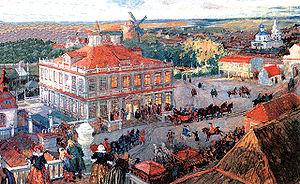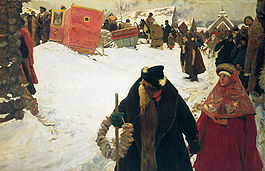
German Quarter
Encyclopedia

Moscow
Moscow is the capital, the most populous city, and the most populous federal subject of Russia. The city is a major political, economic, cultural, scientific, religious, financial, educational, and transportation centre of Russia and the continent...
, located on the right bank of the Yauza River
Yauza River
This article is about a river in Moscow, a tributary of the Moskva River. There are three other Yauza rivers in Central Russia: tributaries of the Lama, Gzhat and Sestra....
east of Kukuy Creek
Stream
A stream is a body of water with a current, confined within a bed and stream banks. Depending on its locale or certain characteristics, a stream may be referred to as a branch, brook, beck, burn, creek, "crick", gill , kill, lick, rill, river, syke, bayou, rivulet, streamage, wash, run or...
(hence, the Kukuy Quarter, or ), within present-day Basmanny District
Basmanny District
Basmanny District is a district of Central Administrative Okrug of Moscow, Russia. Population: The district extends northeast from Kitai-gorod, within the radial boundaries of Vorontsovo Pole Street and Yauza River in the south and Myasnitskaya Street and Novaya Basmannaya Street in the north...
of Moscow.
Its boundaries were defined by present-day Dobroslobodskaya Street and Bolshoy Demidovsky Lane (west, following the track of Kukuy creek), Spartakovskaya Street (north) and Yauza River (south and east). Kukuy formed a wide pond west of present-day Elizavetinsky lane, on site of present-day Sokol stadium of Moscow State Technical University, which occupies the southern half of former German settlement.
Old German Quarter
The German Quarter appeared in the mid-16th century and was populated by foreigners from Western EuropeWestern Europe
Western Europe is a loose term for the collection of countries in the western most region of the European continents, though this definition is context-dependent and carries cultural and political connotations. One definition describes Western Europe as a geographic entity—the region lying in the...
(collectively called "Germans" by the Russian people
Russians
The Russian people are an East Slavic ethnic group native to Russia, speaking the Russian language and primarily living in Russia and neighboring countries....
[NB: the word 'German' in Russian means 'mute']) and prisoners, taken during the Livonian War
Livonian War
The Livonian War was fought for control of Old Livonia in the territory of present-day Estonia and Latvia when the Tsardom of Russia faced a varying coalition of Denmark–Norway, the Kingdom of Sweden, the Union of the Grand Duchy of Lithuania and the Kingdom of Poland.During the period 1558–1578,...
of 1558-1583. The residents of the German Quarter were mainly engaged in handicraft
Handicraft
Handicraft, more precisely expressed as artisanic handicraft, sometimes also called artisanry, is a type of work where useful and decorative devices are made completely by hand or by using only simple tools. It is a traditional main sector of craft. Usually the term is applied to traditional means...
s and flour
Flour
Flour is a powder which is made by grinding cereal grains, other seeds or roots . It is the main ingredient of bread, which is a staple food for many cultures, making the availability of adequate supplies of flour a major economic and political issue at various times throughout history...
-grinding business (that's where the flour mills on the Yauza come from). In the early 17th century, the Old German Quarter was ravaged by the army of False Dmitri II and did not recover afterwards, since many residents relocated closer to Kremlin
Moscow Kremlin
The Moscow Kremlin , sometimes referred to as simply The Kremlin, is a historic fortified complex at the heart of Moscow, overlooking the Moskva River , Saint Basil's Cathedral and Red Square and the Alexander Garden...
or fled the country.
New German Quarter

Time of Troubles
The Time of Troubles was a period of Russian history comprising the years of interregnum between the death of the last Russian Tsar of the Rurik Dynasty, Feodor Ivanovich, in 1598, and the establishment of the Romanov Dynasty in 1613. In 1601-1603, Russia suffered a famine that killed one-third...
, downtown Moscow attracted many European settlers, serving the royal court and the numerous foreign soldiers of muscovite troops. In 1640s, however, the clergy persuaded the tsar to limit foreign presence in Moscow, and in 1652 Alexis I of Russia
Alexis I of Russia
Aleksey Mikhailovich Romanov was the Tsar of Russia during some of the most eventful decades of the mid-17th century...
forced all Catholic
Catholic
The word catholic comes from the Greek phrase , meaning "on the whole," "according to the whole" or "in general", and is a combination of the Greek words meaning "about" and meaning "whole"...
and Protestant foreigners to relocate to German Quarter, which became known as the New German Quarter (Novonemetskaya sloboda
Sloboda
Sloboda was a kind of settlement in the history of Russia, Belarus and Ukraine. The name is derived from the early Slavic word for "freedom" and may be vaguely translated as "free settlement"....
), located east of present-day Lefortovskaya Square, above the mouth of the Chechera River. By 1672, it had three Lutheran and two Calvinist churches and numerous factories, like Moscow's first Silk
Silk
Silk is a natural protein fiber, some forms of which can be woven into textiles. The best-known type of silk is obtained from the cocoons of the larvae of the mulberry silkworm Bombyx mori reared in captivity...
Manufactory, owned by A.Paulsen. In 1701, J.G.Gregory, based in German Quarter, obtained a monopoly
Monopoly
A monopoly exists when a specific person or enterprise is the only supplier of a particular commodity...
patent for a public pharmacy
Pharmacy
Pharmacy is the health profession that links the health sciences with the chemical sciences and it is charged with ensuring the safe and effective use of pharmaceutical drugs...
(hence, the name of Aptekarsky (Pharmacy) Lane).
The quarter was populated by merchants, store owners, and foreign officers of the Russian army
Imperial Russian Army
The Imperial Russian Army was the land armed force of the Russian Empire, active from around 1721 to the Russian Revolution of 1917. In the early 1850s, the Russian army consisted of around 938,731 regular soldiers and 245,850 irregulars . Until the time of military reform of Dmitry Milyutin in...
. Among them were future associates of Peter the Great
Peter I of Russia
Peter the Great, Peter I or Pyotr Alexeyevich Romanov Dates indicated by the letters "O.S." are Old Style. All other dates in this article are New Style. ruled the Tsardom of Russia and later the Russian Empire from until his death, jointly ruling before 1696 with his half-brother, Ivan V...
, such as Patrick Gordon
Patrick Gordon
Patrick Leopold Gordon was general of the Imperial Russian army, of Scottish origin. He was descended from a Scottish family of Aberdeenshire, holders of the small estate of Auchleuchries, the family were connected with the house of Haddo.- Life :He was raised and remained a lifelong Catholic, at...
and Franz Lefort
Franz Lefort
Franz Lefort was a Russian military figure of Swiss origin, general admiral , and close associate of Peter the Great....
. Peter the Great (who grew up nearby, on the eastern bank of Yauza) was a frequent guest in the German Quarter, and he met his mistress Anna Mons
Anna Mons
Anna Mons was a German commonner who almost succeeded in marrying Tsar Peter the Great.- Biography :In 1691, during one of his visits to the German Quarter, young Peter I of Russia became enamoured of Anna Mons, the daughter of Dutch wine merchant Johann Mon. It is generally thought he was from...
there. Deceased residents were buried at the Vvedenskoye Cemetery, also known as German Cemetery, located across Yauza in Lefortovo; this tradition persisted among Lutherans and Catholics until 20th century.
In the early 18th century, the usual way of life in the German Quarter started to change. Its territory gradually turned into a construction site for palaces of the nobles, notably Lefort and later Alexander Bezborodko
Alexander Bezborodko
Prince Alexander Andreyevich Bezborodko was the Grand Chancellor of Russia and chief architect of Catherine the Great's foreign policy after the death of Nikita Panin.-Ukrainian origins:...
(in 1830s, these palaces became the site of Moscow State Technical University). At the same time, foreigners, not bound by former restrictions, migrated to center of Moscow, for example, the French community settled in Kuznetsky Most
Kuznetsky Most
Kuznetsky Most is a street in central Moscow, that runs from Bolshaya Dmitrovka Street to Lubyanka Street. The name, literally Blacksmith's Bridge, refers to the 18th century bridge over Neglinnaya River, now running in an underground tunnel, and a nearby foundry and the settlement of its workers...
.
End of "German" presence

Ribbon
A ribbon or riband is a thin band of material, typically cloth but also plastic or sometimes metal, used primarily for binding and tying. Cloth ribbons, most commonly silk, are often used in connection with clothing, but are also applied for innumerable useful, ornamental and symbolic purposes...
factory etc.
Fire of 1812
Fire of Moscow (1812)
The 1812 Fire of Moscow broke out on September 14, 1812 in Moscow on the day when Russian troops and most residents abandoned the city and Napoleon's vanguard troops entered the city following the Battle of Borodino...
razed the area, and the ruined owners preferred to sell their lands to new owners. By 1826, all foreign landlords sold their land to local merchants and craftsmen; German Quarter lost its ethnic flavor but retained the name of Nemetskaya (German) Street (Baumanskaya Street since 1918). Lutheran churches were never rebuilt; Moscow's Lutheran Cathedral was erected nearly 100 years after the fire in central Basmanny District
Basmanny District
Basmanny District is a district of Central Administrative Okrug of Moscow, Russia. Population: The district extends northeast from Kitai-gorod, within the radial boundaries of Vorontsovo Pole Street and Yauza River in the south and Myasnitskaya Street and Novaya Basmannaya Street in the north...
. The name "German Quarter" itself disappeared from the Moscow lexicon
Lexicon
In linguistics, the lexicon of a language is its vocabulary, including its words and expressions. A lexicon is also a synonym of the word thesaurus. More formally, it is a language's inventory of lexemes. Coined in English 1603, the word "lexicon" derives from the Greek "λεξικόν" , neut...
in the mid-19th century.

